Have you ever called 911? Ever witnessed a terrible accident, a dangerous encounter, or a situation that concerned you enough to dial North America’s emergency line?
If so, you’re not alone.
So why are we making so many 911 calls? When are they made and for what reasons? And are they all legitimate emergencies?
People in America make an estimated 240 million calls to 911 each year. The call content spans every emergency you could imagine from traffic accidents and domestic violence to suspicious people loitering and home invasions.
To learn more, we examined the data for six major U.S. cities from 2015-2016 that have police calls for service data available. Here’s what we learned.
911 IN SEATTLE
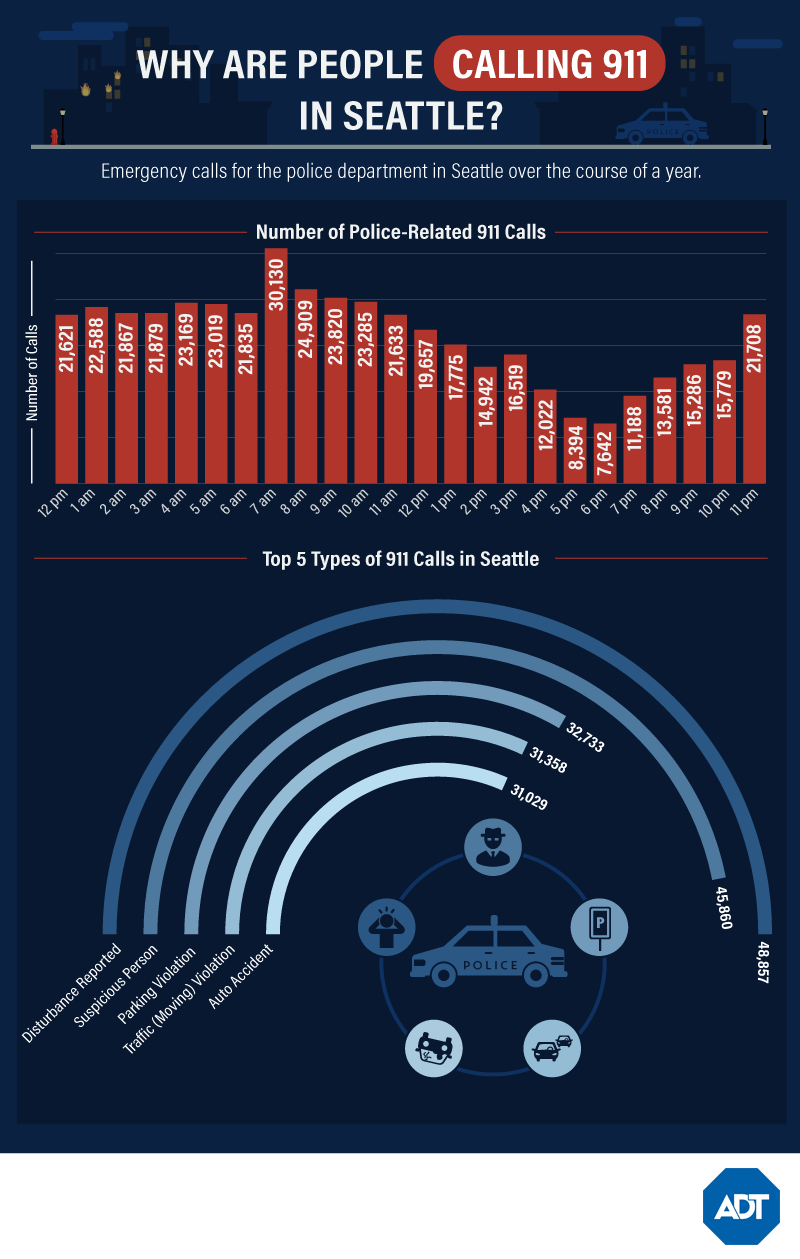
In Seattle, the most police-related 911 calls are made between the hours of 7 a.m. and 8 a.m. It’s impossible to determine why so many occur during this time period but it does make Seattle unique as this is a peak time different from every other city in this study. If the number of calls to police in 2016 regarding suspicious persons and disturbances seems high for a city with a population of around 650,000 you are indeed correct. Seattle has seen a rise in property crimes over the past year, though their rates of violent crimes continue to be lower than average.
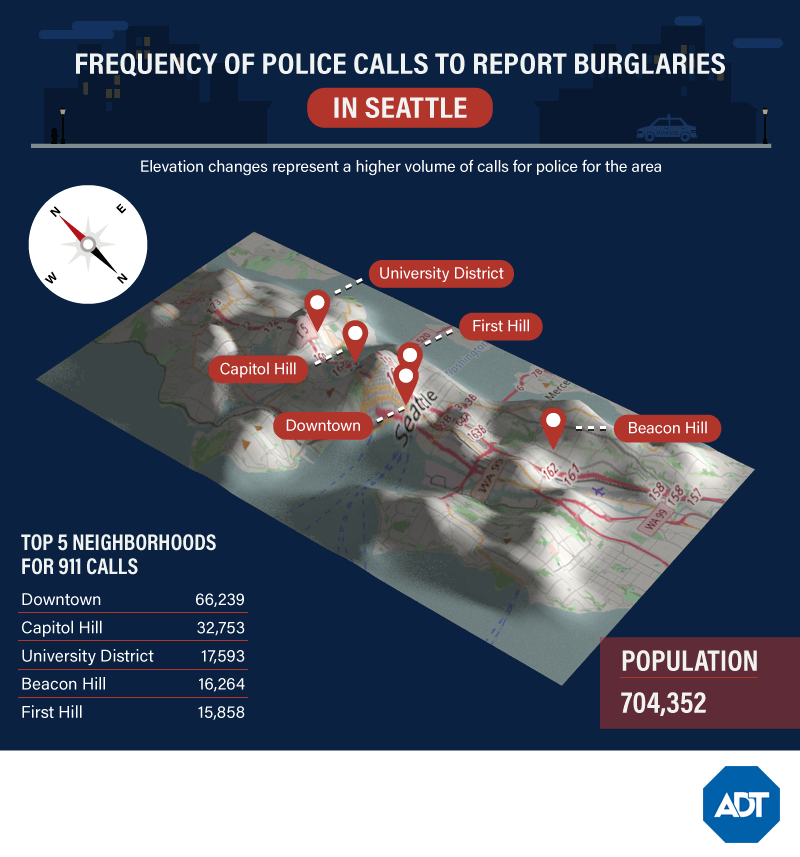
When it comes to burglaries, those 911 calls are concentrated in some specific areas. According to recent Seattle police plans, neighborhoods with higher burglary rates include Ballard North, Ballard South, Bitter Lake, Capitol Hill, Downtown Commercial, Fremont, Lake City, Northgate, Queen Anne, Roosevelt/Ravenna, and Sand Point. To help people learn more about the various neighborhoods, the Seattle city government has created an online crime map to inform residents of what’s going on as well as people that are thinking of moving there.
911 IN DETROIT
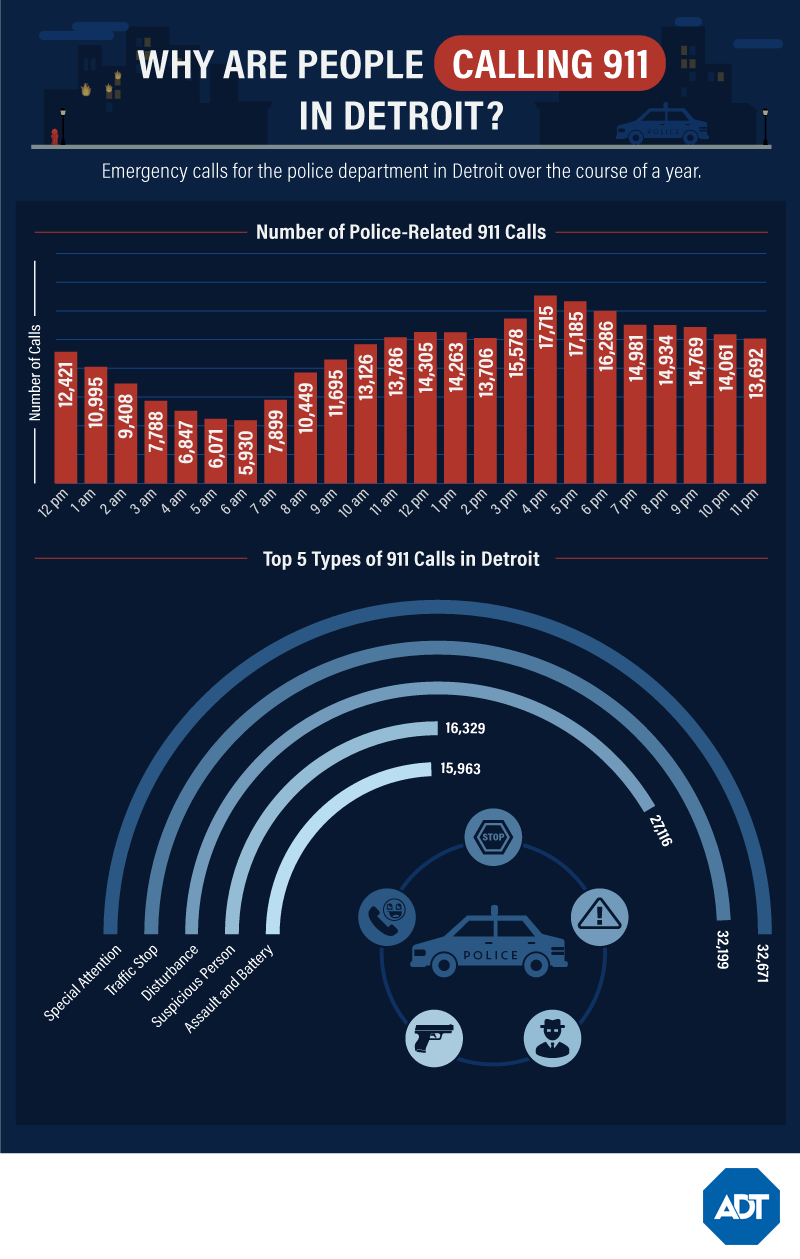
Interestingly, Detroit’s 911 call data look very different from Seattle’s. Most Detroit calls – over 32,000 in fact – fall into the category of hang-ups or prank calls, and they peak around 4 p.m. – in the latter part of a typical workday.
This constant influx of prank calls may be one explanation for why two Detroit 911 operators didn’t take 5-year-old Robert Turner’s call seriously when his mother collapsed in 2006 – a mistake that may have contributed to her death.
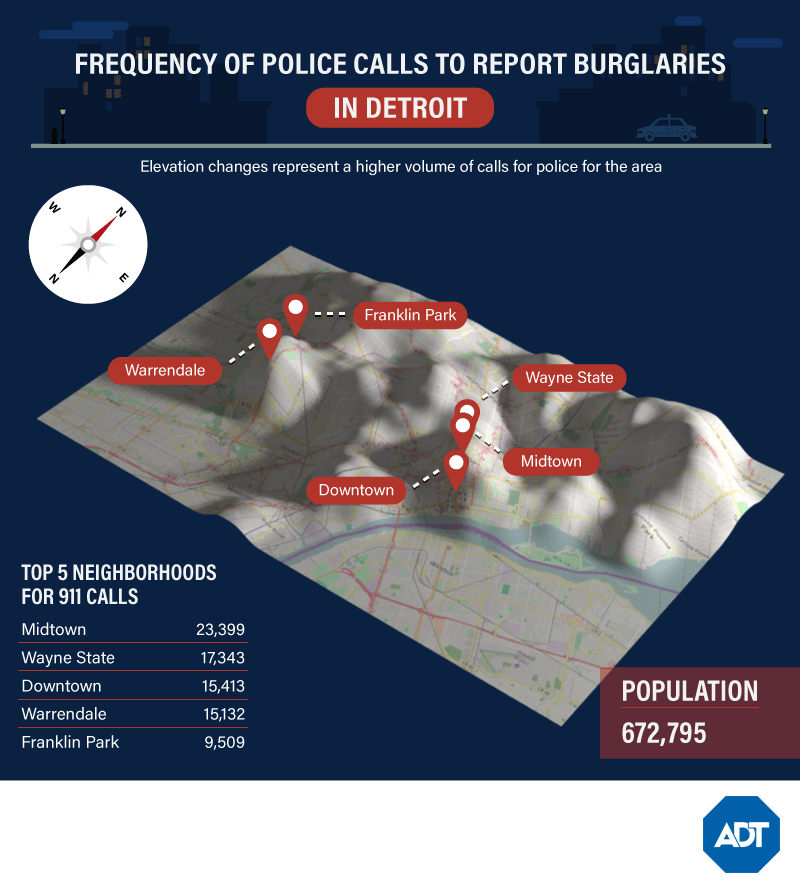
Though it has some peaks and valleys, Detroit’s burglary rates are fairly high across the board. It is often known as the most dangerous city in America due to high violent crime rates, and unfortunately, it seems to be a dangerous one for homeowners as well.
911 IN JERSEY CITY
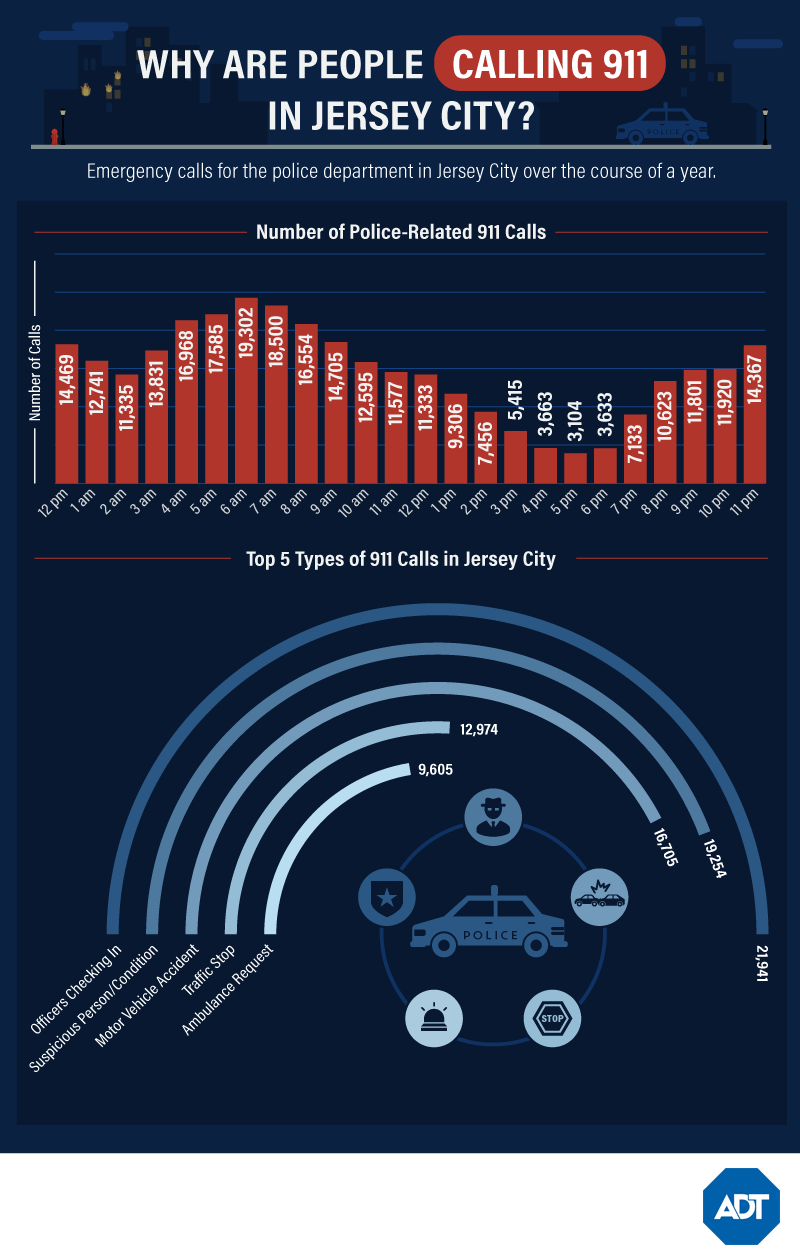
Like our other cities, Jersey City sees a spike in 911 activity in the early morning, culminating at 6 a.m. with the highest call volume. What’s unique about their call data is that unlike the other cities we reviewed, Jersey City Police are required to call in to dispatch when they are eating on the job - hence “officers checking in” are their number one category of call in. The most common nerve-wracking call is to report a suspicious person or situation (more than 11,000 calls), followed closely by calls about car accidents.
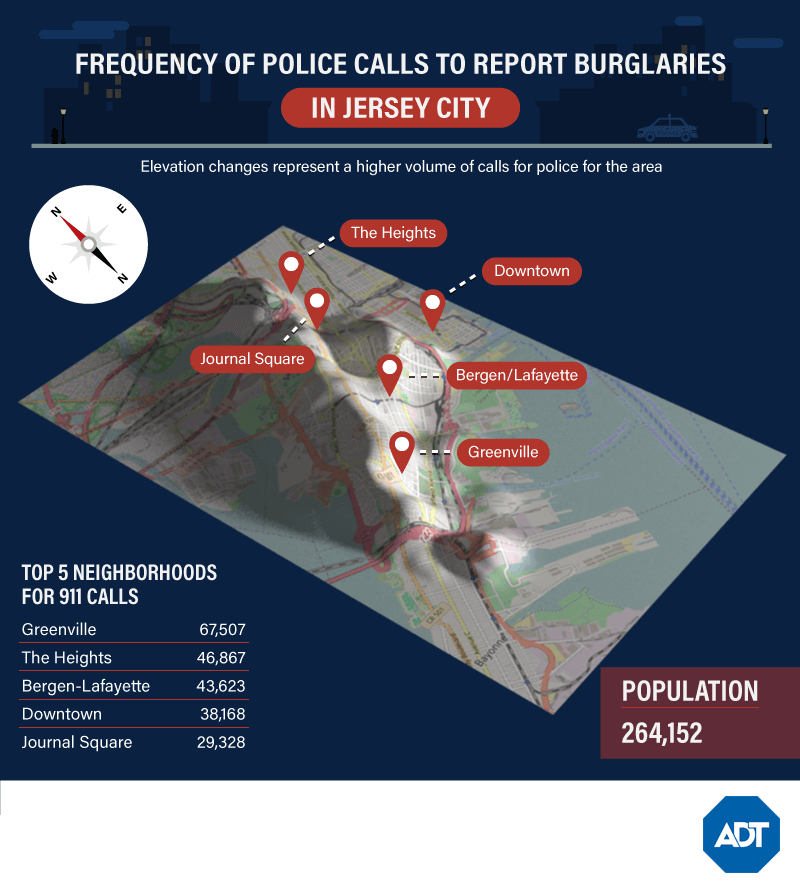
Perhaps the number of suspicious-person calls reflects the danger of break-ins in Jersey City. Property crimes total 4,229 annually and, as you can see from the map above, the highest risk areas run in a ridge pattern right through the center of town.
911 IN NEW ORLEANS
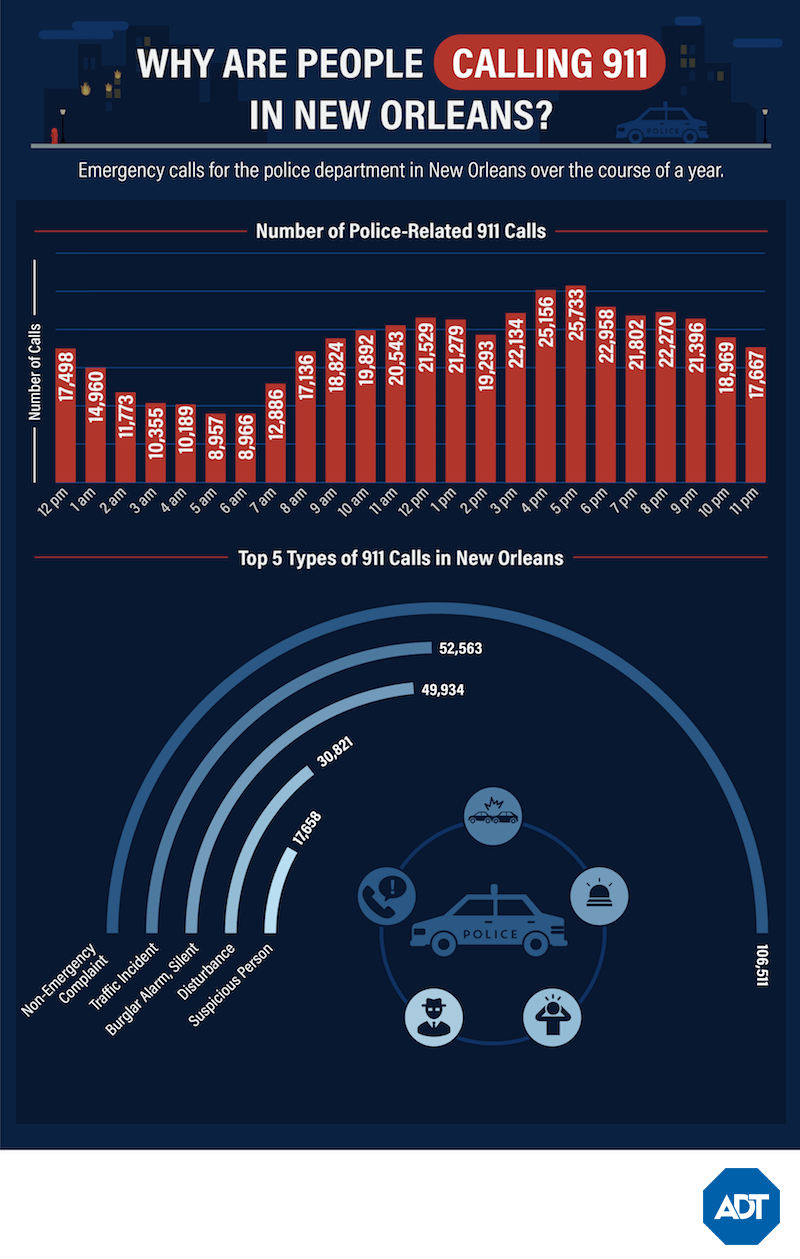
In New Orleans, the 4 and 5 o’clock evening hours are dangerous ones, with significantly more 911 calls than most other times of day.
Interestingly, unlike many of our other cities, non-emergency complaints and traffic incidents are not the most frequent types of calls that operators field. Instead, New Orleans 911 staff face about twice as many “complaint (other)” calls (more than 100,000) than traffic incident calls. And silent burglar alarms alert operators almost as often as traffic incident calls.
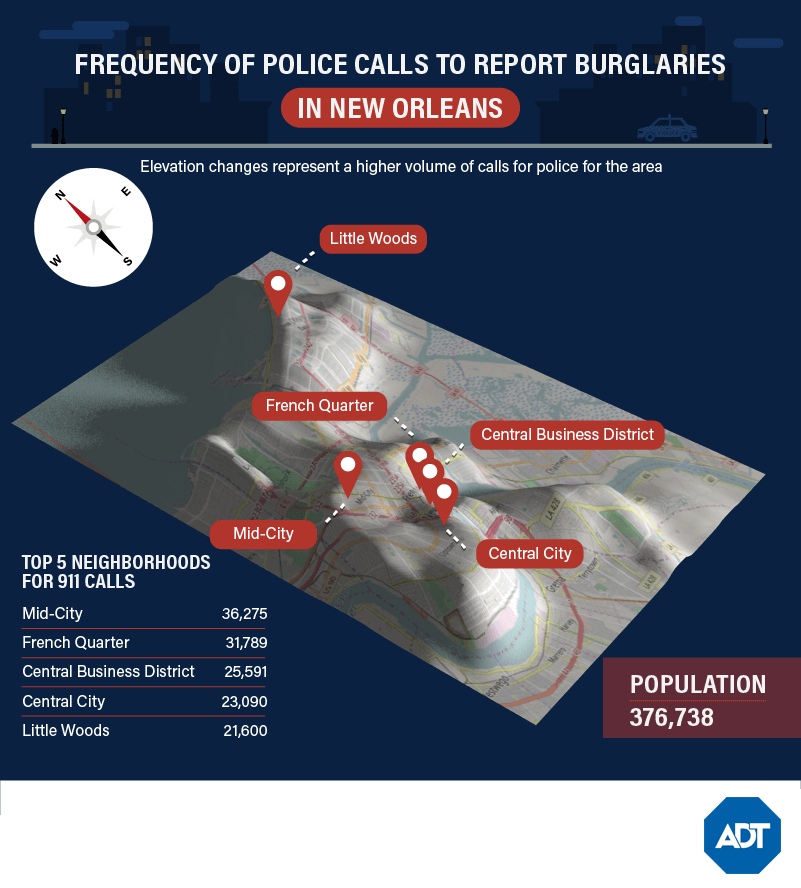
So, where are those silent burglar alarms going off? They’re scattered throughout town, as our map shows. This could be part of the reason that New Orleans is considered to be among the least safe cities in the U.S. (bottom 6 percent), and has nearly four times as many property crimes as Jersey City.
911 IN ORLANDO
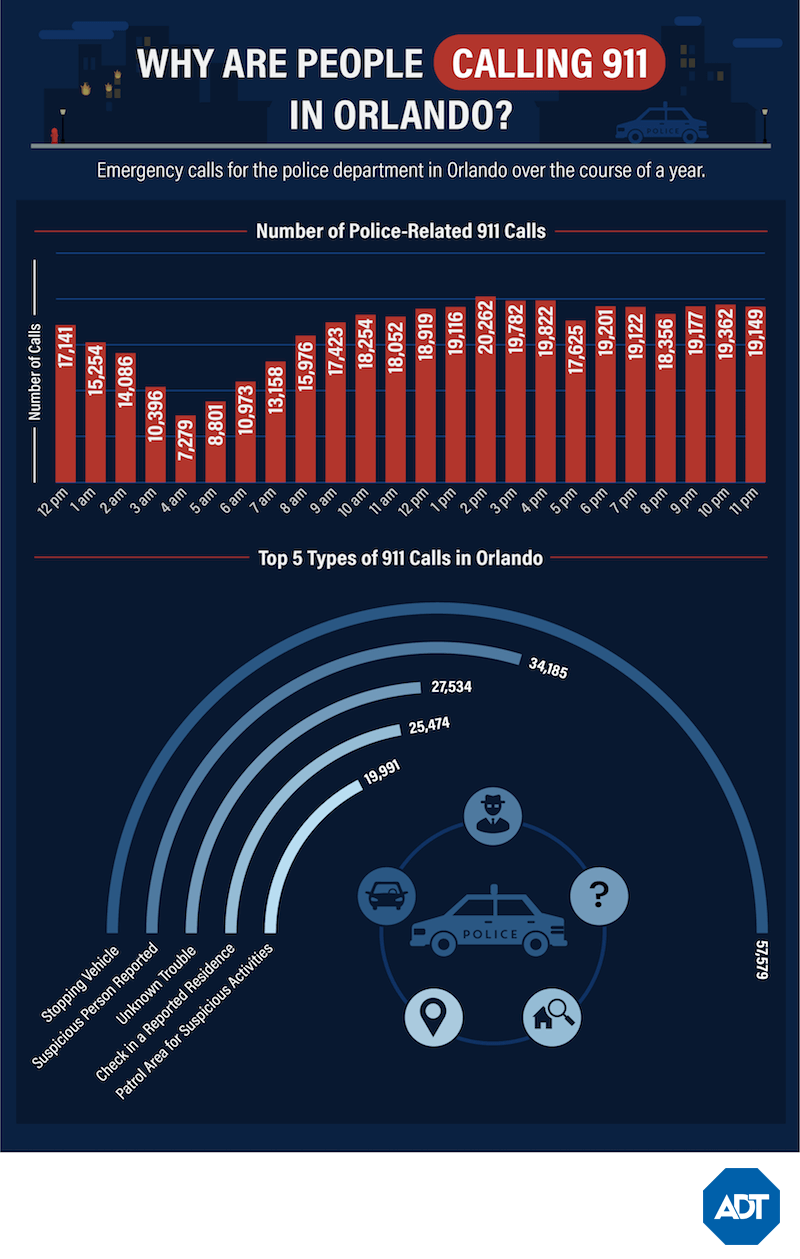
As with some of our other cities, afternoons in Orlando show the highest call volume on 911 lines. And the top crimes or emergencies being reported? Again, traffic issues lead the way, but this time other common issues include suspicious persons, unknown trouble, and house or business checks.
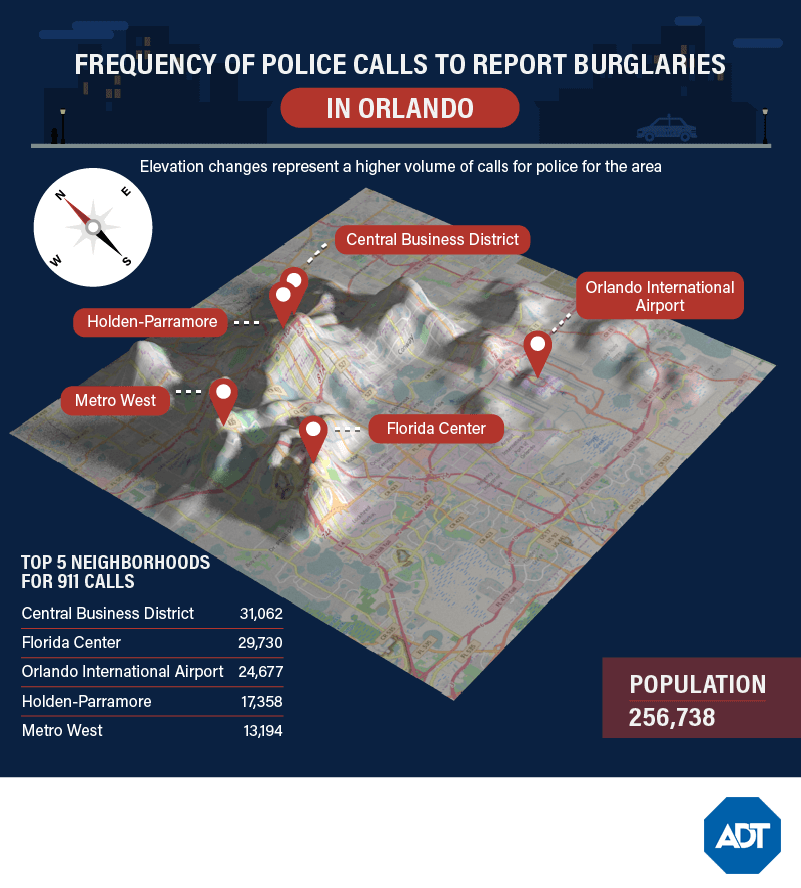
According to our data, the areas with higher burglary risk are mostly concentrated in northern Orlando. According to Neighborhood Scout, the safest neighborhoods overall include Bay Hill and Lake Hart. Annual property crimes top out just under 17,000 – a scary number for any homeowner.
911 IN BALTIMORE
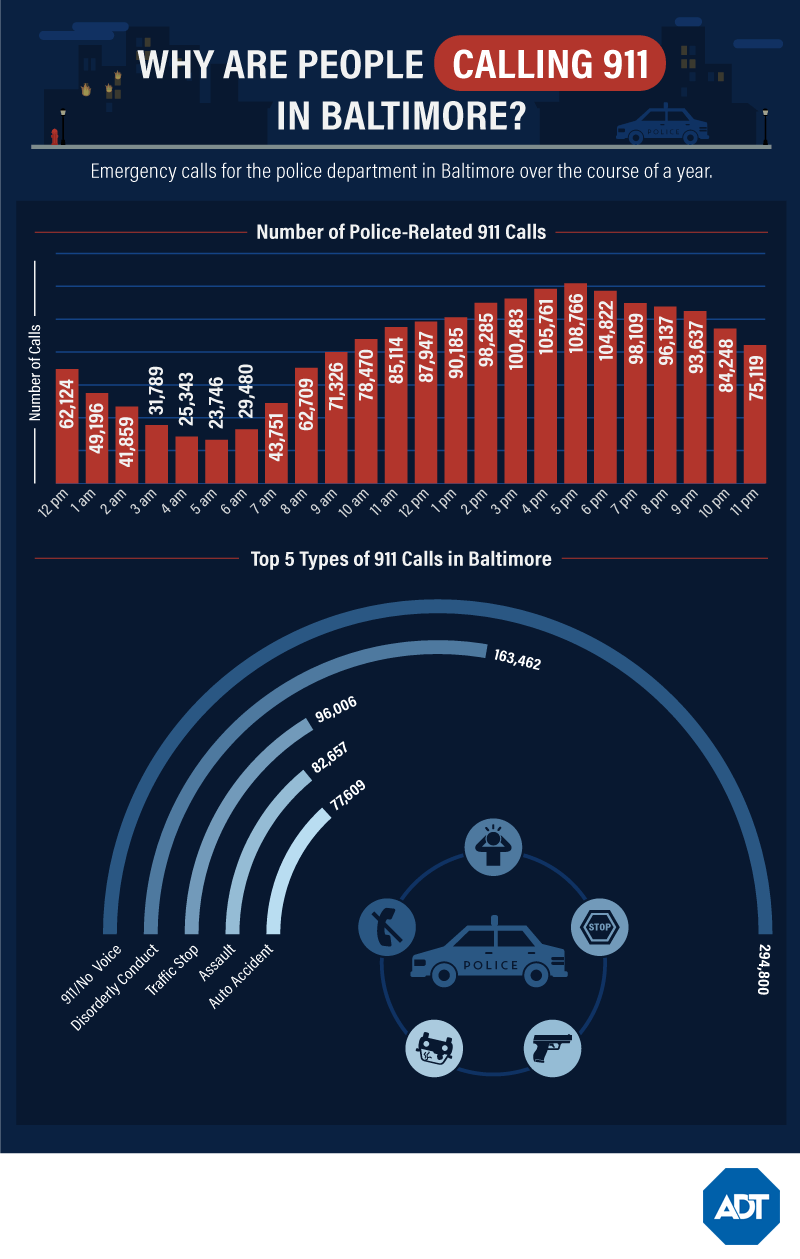
Baltimore’s crime rates are some of the highest in the country, and the violent crime is more than three times as high as Maryland’s average. Offenses like burglaries and other property crimes top 30,000 incidents in Baltimore annually. Baltimore’s other common call-ins include assault and disorderly conduct. And while no voice calls may sound harmless, these occur when operators can’t hear the caller who may be attempting to report a robbery or other dangerous situation.
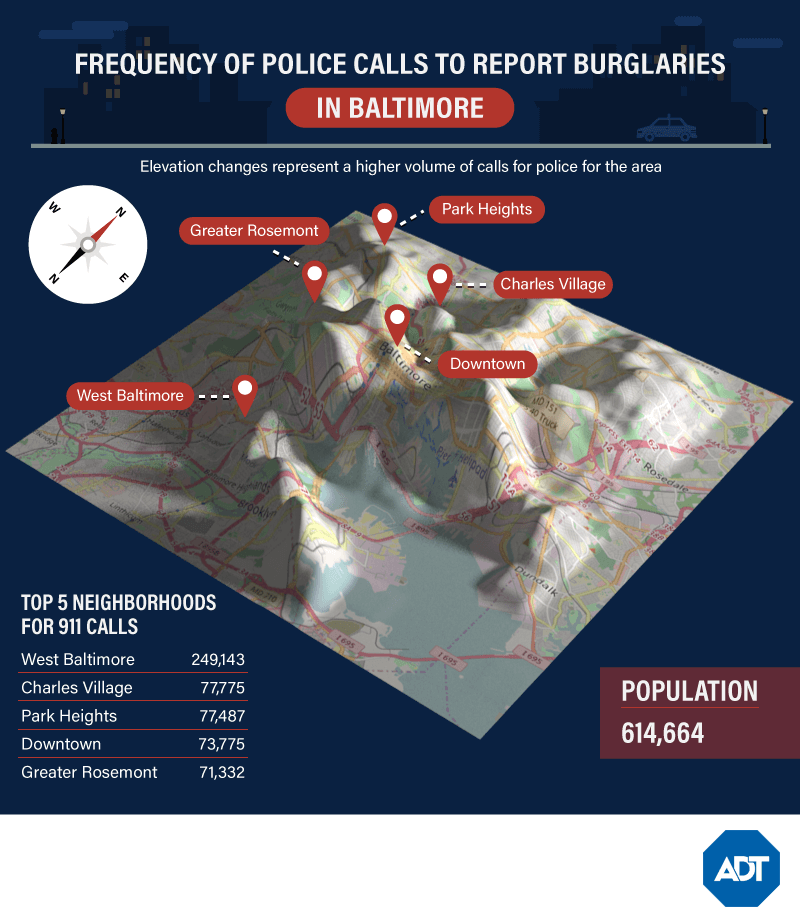
Four of the five Baltimore neighborhoods (Charles Village, Park Heights, Downtown, and Greater Rosemont) with the highest volume of 911 calls were located relatively close to one another. However, none of these four neighborhoods placed as many 911 calls as West Baltimore – almost 250,000 calls between July 2016 and July 2017.
STAYING SAFE IN MAJOR METROPOLITAN AREAS
Across all our data, the most common reasons for 911 calls include traffic accidents and suspicious characters. The good news is that it seems violent or intrusive crimes aren’t as common in some of the cities we studied. The bad news is that those crimes do still exist – and some neighborhoods are less safe than others.
Whether you live in one of the high-risk neighborhoods shown in our maps above or somewhere a bit less risky, we believe it’s always important to protect yourself and your family – which is why we’re in the security business. We help people like you choose a home security system you can trust, with free professional installation thrown in.
Methodology
In order to determine the frequency, time of day, and types of police called, we analyzed cities that made their Calls for Police Service data publicly available. All of these are listed in the sources section below. The maps depicting elevation based upon crime calls, which was inspired by Doug McCune, came from the same data. We used the address given to dispatchers, which they translate into GPS data, to create these maps with elevation. The data are for the years 2015 to 2017. To calculate the figures in the graphics entitled “Why Are People Calling 911 in Seattle," “Why Are People Calling 911 in Detroit," “Why Are People Calling 911 in Jersey City," and, “Why Are People Calling 911 in Baltimore," we used data from 2016-17. To calculate the figures in the graphics entitled “Why Are People Calling 911 in New Orleans?” and “Why Are People Calling 911 in Orlando," we used data from July 2015-16.
SOURCES
- https://www.nena.org/?page=911Statistics
- http://www.geekwire.com/2016/study-traffic-seattle-still-horrible-ranks-2nd-worst-u-s-evening-rush-hour-congestion/
- http://www.nbcnews.com/id/12208992/ns/us_news-life/t/mother-dies-after-call-treated-prank/#.WDM6_KIrKRs
- https://www.neighborhoodscout.com/md/baltimore/crime/
- http://www.usatoday.com/story/money/business/2016/10/01/most-dangerous-cities-america/91227778
- https://www.neighborhoodscout.com/nj/jersey-city/crime/
- https://www.neighborhoodscout.com/la/new-orleans/crime/
- https://www.neighborhoodscout.com/fl/orlando/crime/
- https://www.neighborhoodscout.com/md/baltimore/crime/
- https://www.usfa.fema.gov/data/statistics/
- http://www.seattlepi.com/local/crime/article/Seattle-s-crime-by-the-neighborhood-8394182.php#photo-8856153
- http://dougmccune.com/blog/2010/06/05/if-san-francisco-crime-was-elevation/
- https://data.seattle.gov/Public-Safety/Seattle-Police-Department-911-Incident-Response/3k2p-39jp
- https://data.baltimorecity.gov/Public-Safety/911-Calls-for-Service/xviu-ezkt
- https://data.cityoforlando.net/Orlando-Police/OPD-Calls-for-Service-Data-Lens/uum9-29mz
- http://data.jerseycitynj.gov/dataset/jersey-city-police-department-service-calls-data
- https://data.detroitmi.gov/Public-Safety/DPD-911-Calls-for-Service-September-20-2016-Presen/wgv9-drfc
FAIR USE STATEMENT
While theft is a crime, taking the information and images found here is not. We would ask that if you do use either that you please link back here so that credit can be properly attributed to those that worked on this project.
*This information is accurate as of October 17, 2017. The information is collected from publicly available sources and is only current as of the date indicated and is provided "as is" without warranty of any kind.
© 2018 ADT LLC dba ADT Security Services. All rights reserved. ADT, the ADT logo, ADT Always There and 800.ADT.ASAP and the product/service names listed in this document are marks and/or registered marks. Third party marks are the property of their respective owners.
